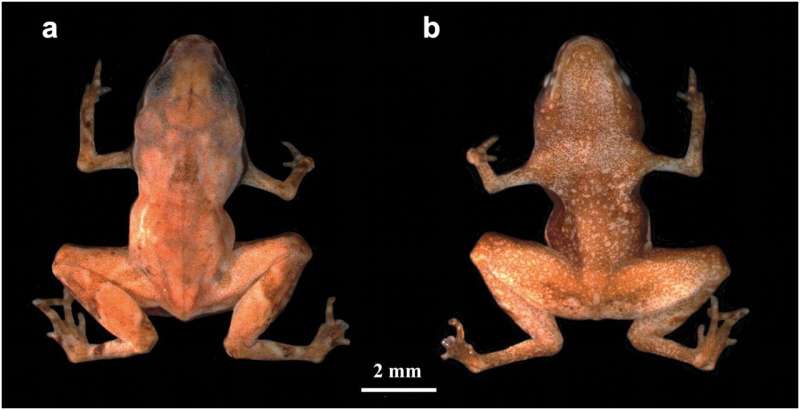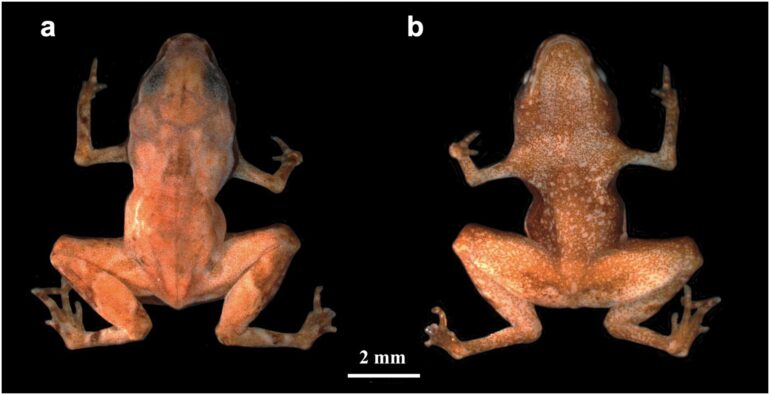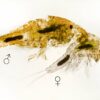Flea toads, as some species in the genus Brachycephalus are known, are less than 1 cm long in adulthood. Their size is far smaller than a fingernail.
The name of a new species, B. dacnis, pays tribute to Project Dacnis, a conservation, research and education NGO that maintains private areas of the Atlantic Rainforest, including the one where the animal was found, in Ubatuba, on the coast of Brazil’s São Paulo state.
“There are small toads with all the characteristics of large toads except for their size. This genus is different. During its evolution, it underwent what we biologists call miniaturization, which involves loss, reduction and/or fusion of bones, as well as fewer digits and absence of other parts of its anatomy,” said Luís Felipe Toledo, corresponding study author and a professor in the Institute of Biology (IB-UNICAMP).
The findings are published in the journal PeerJ.
B. dacnis is the seventh species of flea toad described in the genus Brachycephalus. Until recently, the genus was known mainly for brightly colored species with venom, such as the pumpkin toadlets B. rotenbergae, B. ephippium and B. pitanga, but researchers are now particularly interested in the diminutive size of the flea toads.
Although pumpkin toadlets are larger than flea toads, they have fewer anatomical structures. Curiously, for example, they are unable to hear their own vocalizations due to lack of a tympanic middle ear, as shown by an article published in Scientific Reports in 2017.

Brachycephalus dacnis holotype (ZUEC-AMP 24982) adult male, SVL = 7.55 mm. (A) Dorsal and (B) ventral views. © PeerJ (2024). DOI: 10.7717/peerj.18265
Miniature frog diversity
The researchers’ attention was drawn to the newly described species, B. dacnis, by its vocalizations. It has the same morphology as another species, B. hermogenesi. Both have yellowish-brown skin, live in leaf litter, do not have tadpoles but emerge from their eggs as fully formed miniatures of the adult morphology, and occur in the same region. Their calls are different, however.
DNA sequencing confirmed that B. dacnis was indeed a new species. However, a visit to Picinguaba, a district of Ubatuba where the specimens that permitted the description of B. hermogenesi were found, showed that B. dacnis also occurs there.
“There may have been specimens belonging to the new species among those that served as a basis for describing B. hermogenesi in 1998,” Toledo said, suggesting the use of historical DNA sequencing tools to clear up any remaining uncertainty. Historical DNA is obtained from zoological museum and herbarium specimens.
In their description of the new species, besides the requisite anatomical traits, the researchers included information about the skeleton and internal organs, as well as molecular data and details of its vocalizations. Descriptions of new species must include these details in order to distinguish them from others more precisely, given that many are cryptic and cannot be differentiated by external anatomy only.
“The diversity of these miniature frogs may be far greater than we think. Hence, the importance of describing as many traits and features as possible, to expedite the description process and get to work on conservation as quickly as possible,” Toledo said.
More information:
Luís Felipe Toledo et al, Among the world’s smallest vertebrates: a new miniaturized flea-toad (Brachycephalidae) from the Atlantic rainforest, PeerJ (2024). DOI: 10.7717/peerj.18265
Citation:
Less than 7 mm in length, this Atlantic Rainforest flea toad is the second-smallest vertebrate described in the world (2024, October 29)



